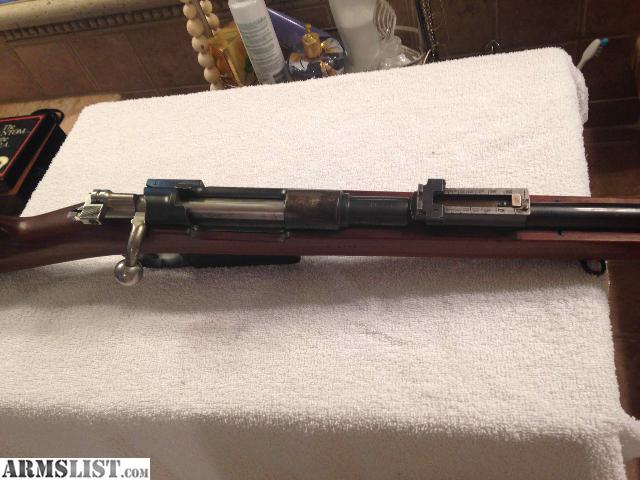Specifications

So are DWMs with A through K serial number prefixes. Special thanks to The Dutchman in Indiana for the first 'in captivity' report on a K-prefix M1895 DWM that is marked 1898. Also thanks to Ed Albers, who spotted another, with serial number K7023.
Year: 1891
Manufacturer(s): Waffenfabrik Mauser AG - Imperial Germany / Fabrique Nationale - Belgium
Roles: Close Quarters Battle (CQB)/Personal Security; Manual Repeat-Fire; Frontline Infantry/Rifleman;
Manufacturer(s): Waffenfabrik Mauser AG - Imperial Germany / Fabrique Nationale - Belgium
Roles: Close Quarters Battle (CQB)/Personal Security; Manual Repeat-Fire; Frontline Infantry/Rifleman;
Action: Manually-Actuated Bolt-Action
Caliber(s): 7.65x53mm Argentine Mauser
Sights: Iron Front and Rear.
Overall Length: 1,295 mm (50.98 in)
Barrel Length: 780 mm (30.71 in)
Weight (Unloaded): 8.82 lb (4.00 kg)
Caliber(s): 7.65x53mm Argentine Mauser
Sights: Iron Front and Rear.
Overall Length: 1,295 mm (50.98 in)
Barrel Length: 780 mm (30.71 in)
Weight (Unloaded): 8.82 lb (4.00 kg)


Muzzle Velocity: 2,100 feet-per-second (640 meters-per-second)
Rate-of-Fire: 12 rounds-per-minute
Rate-of-Fire: 12 rounds-per-minute
Operators: Argentina
Once perfected beyond their early offerings, German Mauser bolt-action rifles proliferated the firearms market of the world by the end of the 1800s and into the early 1900s. If a given bolt-action rifle wasn't a Mauser-based design then it held origins in the competing Austro-Hungarian Mannlicher line of gunes. Mauser manufacturing hubs were eventually established in several other countries including Belgium which begat allows for production of the slightly altered Model 1889 'Belgian Mauser'. This form was more or less faithful to the German design but added a barrel jacket for strength. The design was then adopted by the Ottoman Empire (with some modifications) to become the Model 1890 'Turkish Mauser'. From this design then came the Model 1891 'Argentine Mauser' which, like the Turkish gun, lacked the barrel jacket featured in the Belgian design - a quality ultimately found more detrimental than beneficial.An Argentine government commission sought to replace earlier Model 1871s in Argentine service and contracted with Mauser in 1886 to upgrade their existing stocks. The result was adoption of the Model 1891 largely based on the Model 1890 Turkish Mauser though with subtle modifications to suit the Argentine Army requirement. This included a revised bolt assembly and reinforced extractor unit while being chambered for the local 7.65x53mm Argentine Mauser cartridge. On every other quality however the Argentine Mauser was essentially the Turkish variant and a Mauser long gun through and through.
The Model 1891 featured a single-piece wood stock with a straight-wrist grip section. The bolt handle held the typical knob at its end for ease of use and the assembly sat over the right side of the gun. The trigger loop was underslung in the usual way with a projecting magazine case featured just ahead of the trigger unit. The metal working components were inlaid to the woodwork and a single band joined the stock to the barrel. Sighting was through iron fixtures across the top of the frame and at the muzzle. The weapon was fed through a 5-round integral box magazine. As with other rifles of the period, Argentine Mausers held provision for the mounting of a bayonet.
As a bolt-action weapon, the rifle required manual actuation of the bolt system to strip a fresh cartridge from the awaiting integral magazine and enter said cartridge into the firing chamber, providing the effective lock and seal for the bullet prior to firing. Muzzle velocity reached 2,100 feet per second with the weapon ranged out to about 2,080 yards. As with other Mausers, Argentine versions were equally long (51 inches overall) and heavy (8.8lb) but structurally strong and robust under adverse combat conditions.
Beyond the standard long gun form, the Argentine Army adopted the weapon in a 'Model 1891 Cavarly Carbine' variant, these weapons being shortened (to 37 inches) for a more compact profile - suitable for cavalry troops in the field. The original Model 1891 long gun was eventually updated during 1909 to produce the Model 1891/09 designation - the guns given regraduated sights following the widespread adoption by global militaries of the pointed 'Spitzer' bullet. Pointed bullets succeeded the older rounded bullet types.
1909 Argentine Mauser Serial Numbers
Argentine Mauser Serial Numbers
Variants / Models
• Model 1891 - Base Series Designation; original production forms based on the Turkish Mauser; chambered for 7.65x53mm Argentine Mauser cartridge.
• Model 1891 Cavalry Carbine - Shortened cavalry carbine form for mounted and specialist troops; 37' length.
• Model 1891/09 - Update of 1909 for pointed Spitzer bullets; regraduated sights.